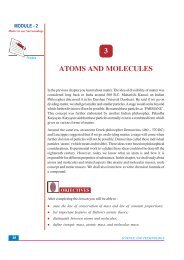8. Acids, Bases and Salts (41.1 MB)
8. Acids, Bases and Salts (41.1 MB)
8. Acids, Bases and Salts (41.1 MB)
You also want an ePaper? Increase the reach of your titles
YUMPU automatically turns print PDFs into web optimized ePapers that Google loves.
MODULE - 2<br />
Matter in our Surroundings<br />
Notes<br />
<strong>Acids</strong>, <strong>Bases</strong> <strong>and</strong> <strong>Salts</strong><br />
From this activity, we can conclude that the reaction between copper oxide <strong>and</strong> dilute<br />
hydrochloric acid results in the formation of copper (II) chloride (cupric chloride)<br />
which is a salt of copper. This salt forms bluish green solution. The reaction is:<br />
CuO(s) + 2HCl(aq) ⎯→ CuCl 2 (aq) + H 2 O(l)<br />
copper dil. hydrochloric copper (II) water<br />
oxide acid chloride<br />
Many other metal oxides like magnesium oxide (MgO) <strong>and</strong> calcium oxide (CaO)<br />
or quick lime also react with acid in a similar way. For example,<br />
CaO(s) + 2HCl(aq) ⎯→ CaCl 2 (aq) + H 2 O(l)<br />
calcium oxide dil. hydrochloric calcium chloride water<br />
(quick lime)<br />
acid<br />
So, we can summarize with a general reaction between metal oxides <strong>and</strong> acids as:<br />
Metal oxide + Acid ⎯→ Salt + Water<br />
7. Reaction of acids with bases<br />
Let us study the reaction of acids with bases with the help of the following activity.<br />
ACTIVITY <strong>8.</strong>5<br />
This activity may be carried out in the chemistry laboratory of your study centre.<br />
Aim : To study the reaction between acids <strong>and</strong> bases.<br />
What is required?<br />
A test tube, dropper, phenolphthalein indicator, solution of sodium hydroxide <strong>and</strong> dil.<br />
hydrochloric acid.<br />
What to do?<br />
<br />
<br />
<br />
<br />
Take about 2 mL solution of sodium hydroxide in a test tube.<br />
Add a drop of phenolphthalein indicator to it <strong>and</strong> observe the colour.<br />
With the help of a dropper add dil. HCl dropwise <strong>and</strong> stir the solution constantly<br />
till the colour disappears.<br />
Now add a few drops of NaOH solution. The colour of the solution is restored.<br />
164<br />
SCIENCE AND TECHNOLOGY
















